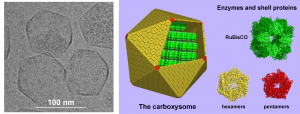2001, DOI: 10.1046/j.1365-313x.2001.01056.x
Form I Rubiscos from non-green algae are expressed abundantly but not assembled in tobacco chloroplasts
Abstract
 Non-green algae have Rubiscos that are phylogenetically distinct from their counterparts in green algae and higher plants. Some non-green-algal Rubiscos are more specific for CO2, relative to O-2, than higher-plant Rubiscos, sometimes coupled with lower Michaelis constants for CO2. If these Rubiscos could be substituted for the higher-plant enzyme, and if they functioned successfully in the higher-plant chloroplast and were regulated appropriately, they would improve the CO2 use and quantum efficiency of higher-plant photosynthesis. To assess the feasibility of expressing non-green algal Rubiscos in higher-plant chloroplasts, we inserted the rbcLS operons from the rhodophyte Galdieria sulphuraria and the diatom Phaeodactylum tricornutum into the inverted repeats of the plastid genome of tobacco, leaving the tobacco rbcL gene unaltered. Homoplasmic transformants were selected. The transgenes directed the synthesis of abundant amounts of transcripts and both subunits of the foreign Rubiscos. In some circumstances, leaves of the transformants with the P. tricornutum Rubisco contained as much foreign Rubisco protein as endogenous tobacco Rubisco (>30% of the soluble leaf protein). However, the subunits of the foreign Rubiscos were not properly folded and/or assembled. All the foreign large subunits and most of the foreign small subunits were recovered in the insoluble fractions of leaf extracts. Edman sequencing yielded the expected N-terminal sequences for the foreign small subunits but the N-termini of the foreign large subunits were blocked. Accumulation of large amounts of denatured foreign Rubisco in the leaves, particularly of the P. tricornutum transformants, caused a reduction in the amount of tobacco Rubisco present, with concomitant reductions in leaf CO2 assimilation and plant growth.
Non-green algae have Rubiscos that are phylogenetically distinct from their counterparts in green algae and higher plants. Some non-green-algal Rubiscos are more specific for CO2, relative to O-2, than higher-plant Rubiscos, sometimes coupled with lower Michaelis constants for CO2. If these Rubiscos could be substituted for the higher-plant enzyme, and if they functioned successfully in the higher-plant chloroplast and were regulated appropriately, they would improve the CO2 use and quantum efficiency of higher-plant photosynthesis. To assess the feasibility of expressing non-green algal Rubiscos in higher-plant chloroplasts, we inserted the rbcLS operons from the rhodophyte Galdieria sulphuraria and the diatom Phaeodactylum tricornutum into the inverted repeats of the plastid genome of tobacco, leaving the tobacco rbcL gene unaltered. Homoplasmic transformants were selected. The transgenes directed the synthesis of abundant amounts of transcripts and both subunits of the foreign Rubiscos. In some circumstances, leaves of the transformants with the P. tricornutum Rubisco contained as much foreign Rubisco protein as endogenous tobacco Rubisco (>30% of the soluble leaf protein). However, the subunits of the foreign Rubiscos were not properly folded and/or assembled. All the foreign large subunits and most of the foreign small subunits were recovered in the insoluble fractions of leaf extracts. Edman sequencing yielded the expected N-terminal sequences for the foreign small subunits but the N-termini of the foreign large subunits were blocked. Accumulation of large amounts of denatured foreign Rubisco in the leaves, particularly of the P. tricornutum transformants, caused a reduction in the amount of tobacco Rubisco present, with concomitant reductions in leaf CO2 assimilation and plant growth.
